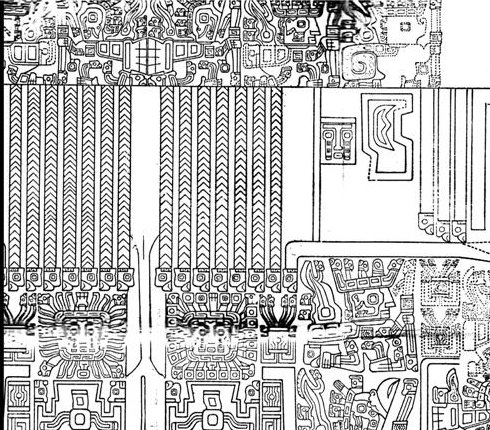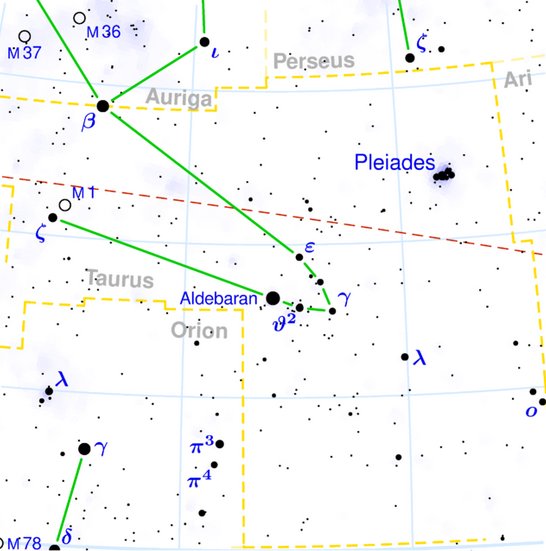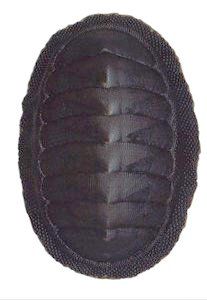A chiton
can also be completely
black and such a
creature could be more likely to have
inspired the mama
type of glyph:
On the
back (dark) side of the
head of Pachamama
her tresses show wedges
(around 184 + 216 = 400
of them) oriented
upwards:

This
orientation upwards is
the opposite to the
orientation downwards in
Ga7-3.
"Religion
then, as among other
peoples of the
continent, was an
animism based on cosmic
philosophy, in which all
the phenomena of nature
and all visible things
which had a relation
with material life, were
animated. The ground,
the food-giving earth,
was Pachamama;
the moon, Paximama;
the lake, Kochomama.
Even the wind was a
divine being,
Huayra-huirakjocha.
The hills and especially
the volcanos were also
considered to be
divinities and were
called Achachilas. [A
footnote explains
achachi as
grandfather]" (Arthur
Posnansky, Tihuanacu
the Cradle of American
Man.)
From 5 downward dark wedges
inside the 'overturned
canoe' (chiton,
mama) in Ga7-3 (a
glyph number now easy to
remember) emerges a kind
of arm stretching
upwards and ending at
the top with 3 wedges
oriented upwards. In
front of this triplet
the light is allowed
in, we can see from the
gap (vaha) between the arm and
the 'roof':
 |
 |
 |
 |
 |
|
Ga7-2 |
Ga7-3
(172) |
Ga7-4 |
Ga7-5 |
Ga7-6 |
|
θ Cor.
Borealis
(235.3), γ
Lupi
(235.6),
Gemma,
Zuben
Elakrab,
Qin, ε Tr.
Austr.
(235.7), μ
Cor.
Borealis
(235.8)
Sirrah
|
φ Bootis
(236.2),
ω Lupi
(236.3),
ψ╣ Lupi
(236.7),
ζ Cor.
Borealis
(236.9) |
ι
Serpentis
(237.4),
ψ▓ Lupi
(237.5),
γ Cor.
Borealis
(237.7),
Unuk
Elhaia
(237.9) |
π Cor.
Borealis,
Cor
Serpentis
(238.1),
Chow
(238.6) |
κ
Serpentis
(239.3),
δ Cor.
Borealis,
Tiānrǔ
(239.5),
χ Lupi,
(239.6),
ω
Serpentis
(239.7),
Ba, χ
Herculis
(239.8).
κ Cor.
Borealis,
ρ
Serpentis
(239.9) |
|
Ko Ruti
11 (315) |
12 |
13 |
14 |
15 |
|
║November
7 (*231) |
8 |
9 |
10 (314) |
11 |
|
'October
15
(288) |
16 |
17
(*210) |
18 |
19 |
|
"October
1 (274) |
2 |
3 |
4 |
5 (*198) |
|
no star
listed
(52) |
no star
listed
(53)
Acrux |
no star
listed
(54) |
Al
Thurayya-27
/
Krittikā-3
/
Hairy
Head-18 |
|
Atiks,
Rana
(55.1),
CELAENO,
ELECTRA,
TAYGETA
(55.3),
MAIA,
ASTEROPE,
MEROPE
(55.6) |
ALCYONE
(56.1),
PLEIONE,
ATLAS
(56.3) |
|
TAU-ONO |
|
Vaitu Potu
12 |
13 |
14 |
15 |
16 (136) |
|
║May
9 (128) |
10 (*49) |
11 |
12 |
13 |
|
'April 15
(*25) |
16 |
17 (107) |
18 |
19 |
|
"April
1 (91) |
2 |
3 (*13) |
4 |
5 |
 |
 |
 |
 |
| Ga7-7 |
Ga7-8 |
Ga7-9 |
Ga7-10 (179) |
| β Tr. Austr. (240.3), κ Tr. Austr. (240.4), ρ Scorpii (240.8) |
Iklīl al Jabhah-15 / Anuradha-17 / Room-4 |
ε Cor. Borealis (241.5), υ Herculis (242.3), ρ Cor. Borealis (242.4), ι Cor. Borealis (242.5), ξ Scorpii (242.7) Schedir
|
16h (243.5) |
| ξ Lupi, λ Cor. Borealis (241.1), Zheng (241.2), VRISCHIKA (241.3), ε Cor. Borealis (241.5), Dschubba (241.7), η Lupi (241.9) |
Acrab, Jabhat al Akrab (243.3), θ Lupi, Rutilicus (243.5), Marfik (243.7), φ Herculis (243.8) |
| Ko Ruti 16 (320) |
17 |
18 |
19 |
|
║November
12
(*236) |
13 |
14 (318) |
15 |
|
'October
20 |
21 (*214) |
22 (295) |
23 |
|
"October
6 (*199) |
7 (280) |
8 |
9 |
| Menkhib (57.6) Porrima
|
Zaurak (58.9) |
λ Tauri (59.3), ν Tauri (59.9) |
4h (60.9) |
| no star listed (60) Cor Caroli |
|
Vaitu Potu
17 |
18 |
19 |
20 (140) |
|
║May
14 |
15 (*54) |
16 |
17 (136) |
|
'April 20 (*30) |
21 (111) |
22 |
23 |
|
"April
6 |
7 |
8 (*18) |
9 (99) |
"The
preferred wood for
hare paenga
construction is said to
have been
toromiro,
bur
hau (Triumfetta
semitriloba),
marikuru (Sapindus
saponaria) or
mako'i (Thespesia
populnea) were
variously used ... Three
layers of thatch (hatunga)
were secured to the
wooden framework in a
horizontal mannerů
The inner
layer was of mats (moenga)
made of reeds (Scirpus
californicus) and
sewn together with
hau cords. The
middle layer was
composed of sugar cane
leaves (toa or
rau toa) which were
also probably sewn
together to form
matwork. The topmost
layer was of bundled
grass (mauku),
laid horizontally and
held in place by purlins
(kaukau miro)
...
The
hau cords which
secured the purlins to
the rafters and the
rafters to the ridge
pole were always to be
knotted towards the
right and in three
revolutions, 'like
[tying off] the
umbilical cord of a
baby'.
A similar
practice was once
utilised (and
occasionally still is)
to fasten the lines on a
boat. Hotu Matu'a,
they said, had promised
that if this triplicate
practice were followed,
fishermen would not lose
their lives when their
boats capsized at sea
and hare paenga
would not be torn from
their foundations by the
wind." (Jo Anne Van
Tilburg, Easter
Island. Archeology,
Ecology and Culture.)
A child (tamaiti)
emerges
180 days counted from
the beginning of the
text and now the Hyades door
is not heliacal but close to the Full
Moon:
 |
 |
|
tamaiti |
Ga7-11 (180) |
|
Tama
1. Shoot (of
plant),
tama miro,
tree
shoot;
tama t˘a,
shoot of
sugarcane.
2. Poles,
sticks, rods
of a frame.
3. Sun rays.
4. Group of
people
travelling
in
formation.
5. To listen
attentively
(with ear,
tariga,
as subject,
e.g. he
tama te
tariga);
e-tama
rivariva
tokorua
tariga ki
taaku kţ,
listen
carefully to
my words.
Tamahahine,
female.
Tamahine
(=
tamahahine),
female, when
speaking of
chickens:
moa
tamahine,
hen.
TamÔroa,
male.
Vanaga.
1. Child. P
Pau.:
tama riki,
child. Mgv.:
tama,
son,
daughter,
applied at
any age.
Mq.: tama,
son, child,
young of
animals.
Ta.: tama,
child.
Tamaahine
(tama
1 - ahine),
daughter,
female.
Tamaiti,
child P Mq.:
temeiti,
temeii,
young
person. Ta.:
tamaiti,
child.
Tamaroa,
boy, male. P
Mgv.:
tamaroa,
boy, man,
male. Mq.:
tamaˇa,
boy. Ta.:
tamaroa,
id. 2. To
align.
Churchill.
In the
Polynesian
this [tama
na,
father in
the EfatÚ
language] is
distinguished
from tßma
child by the
accent
tamā
or by the
addition of
a final
syllable
which
automatically
secures the
same
incidence of
the accent,
tamßi,
tamana
...
Churchill 2 |
At
the time of heliacal
σ Scorpii
(ruling the 5th
Chinese station
Heart) the
Hyades gate was at
the Full Moon and
the first completed
cycle in the text
was
reached:
 |
no glyph |
 |
 |
|
Ga1-1 |
Ga1-2 |
|
Hyadum
II (δ╣
Tauri)
(64.2) |
Net-19 |
no star
listed
(66) |
|
AIN,
θ╣
Tauri,
θ▓ Tauri
(65.7) |
|
May 24
(5-24) |
25 (*65
+ 80 =
145) |
26 (146
+ 366 =
512) |
|
║May 20
(5-20) |
21 (*65
- 4 + 80
= 141) |
22 (142
+ 366 =
508) |
|
'April
27
(4-27) |
28 (*65
- 27 +
80 =
118) |
29 (119
+ 366 =
485) |
|
"April
13
(4-13) |
14 (*65
- 41 +
80 =
104) |
15 (105
+ 366 =
471) |
|
Heart-5 |
ρ
Ophiuchi
(248.1),
Kajam
(248.3),
χ
Ophiuchi
(248.5),
She Low,
ι Tr.
Austr.
(248.7),
ζ Tr.
Austr.
(248.8) |
Al Kalb-16
/
Jyeshtha-18
/
ANA-MUA |
|
σ
SCORPII
(247.0),
Hejian
(247.2),
ψ
Ophiuchi
(247.7) |
ANTARES
(249.1),
Marfik,
φ
Ophiuchi
(249.5),
ω
Ophiuchi
(249.8) |
|
November
23
(*247) |
24 (145
+ 183 =
328) |
25 (*249
+ 80 =
329) |
|
║November
19
(*243) |
20 (141
+ 183 =
324)
|
21 (*245
+ 80 =
325) |
|
12 * 12
= 144
and 156
= 12 *
13 = 300
- 144.
12 * 14
= 168
and 300
+ 168 =
468 = 12
* 39. |
'October
27 (300) |
28 (118
+ 183 =
301) |
29 (*222
+ 80 =
302) |
|
12 * 15
= 180
and 468
+ 180 =
648 = 2
* 324 =
12 * 54
= 24 *
27 = 3 *
216 = 6
* 108. |
"October
13
(*206) |
14 (104
+ 183 =
287) |
15 (*208
+ 80 =
288) |
After
having
eliminated a lot of
small details and
once again improved my way
of presentation the
overview becomes:
 |
no glyph |
 |
 |
|
Ga1-1 |
Ga1-2 |
|
Hyadum II
(δ╣ Tauri)
(64.2) |
Net-19 |
no star
listed (66) |
|
AIN,
θ╣ Tauri, θ▓
Tauri
(65.7) |
|
May 24 |
25 (145) |
26 |
|
║May 20
(*60) |
21 (141) |
22 |
|
'April 27 (*37) |
28 (118) |
29 |
|
'Vaitu
Nui 27 (*37) |
28 (118) |
29 |
|
"April 13
(*23) |
14 (104) |
15 |
|
Heart-5 |
ρ Ophiuchi
(248.1),
Kajam
(248.3), χ
Ophiuchi
(248.5), She
Low, ι Tr.
Austr.
(248.7), ζ
Tr. Austr.
(248.8) |
Al Kalb-16
/
Jyeshtha-18
/
ANA-MUA |
|
σ SCORPII
(247.0),
Hejian
(247.2), ψ
Ophiuchi
(247.7) |
ANTARES
(249.1),
Marfik, φ
Ophiuchi
(249.5),
ω Ophiuchi
(249.8) |
|
November 23 |
24 |
25 (329) |
|
║November 19 |
20 (*244) |
21 (325) |
|
'October
27 (300) |
28 |
29 (*222) |
|
'Tagaroa Uri 27
(300) |
28 |
29 (*222) |
|
"October 13
(286) |
14 |
15 (*208) |
|
He Anakena |
Hora Iti |
Hora Nui |
Tagaroa Uri |
Ko Ruti
|
Ko Korˇ |
|
'July' |
'August' |
'September' |
'October' |
'November' |
'December' |
|
Tua Haro |
Tehetu'up˙ |
Tarahao |
Vaitu Nui |
Vaitu Potu |
He Maro |
|
'January' |
'February' |
'March' |
'April' |
'May' |
'June' |
The
reason for beginning the
text at the heliacal
Hyades gate could be the
new months introduced by
Julius Caesar (July and
August). Should we
eliminate these, then
June (the 6th month)
would be the month
immediately before the
7th month (September).
The Hyades gate would
not be in May (the 5th month) but in the 3rd month (March). And Gregorius XIII
changed the March equinox day from number 25 to number 21 with the glyph text
beginning where the previous date for spring equinox was.
|








